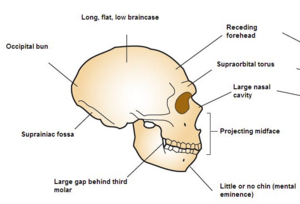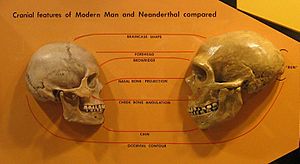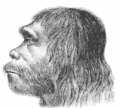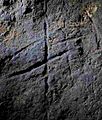Neanderthal facts for kids
Quick facts for kids NeanderthalTemporal range: Pleistocene
|
|
|---|---|
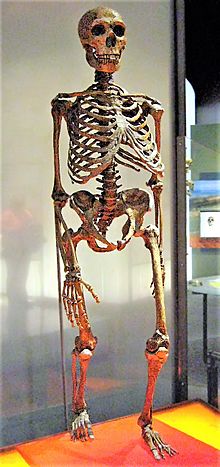 |
|
| Skeleton in the American Museum of Natural History, Manhattan | |
| Conservation status | |
| Scientific classification | |
| Kingdom: | |
| Phylum: | |
| Class: | |
| Order: | |
| Family: | |
| Genus: | |
| Binomial name | |
| †Homo neanderthalensis King, 1864
|
|
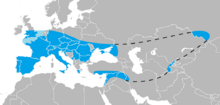 |
|
| Neanderthal range | |
The Neanderthal was a type of human that lived a long time ago. Its scientific name is Homo neanderthalensis. They were very close relatives to modern humans, Homo sapiens.
Neanderthal fossils have been found in Europe, Asia Minor, and parts of central Asia. The very first fossil was discovered in 1856 in a limestone quarry near Düsseldorf, Germany. A worker found part of a skeleton in a valley called Neanderthal. Experts later said these bones belonged to an older type of human. Today, these bones are known as Neanderthal 1.
Scientists believe Neanderthals became extinct around 40,000 years ago. It's tricky to figure out the exact date because of how old the archaeological sites are where their remains were found.
Neanderthals might have developed from an older human species called Homo heidelbergensis. They likely split off from modern humans between 700,000 and 300,000 years ago.
For a while, Neanderthals were thought to be a subspecies of modern humans (Homo sapiens neanderthalensis). But now, most scientists classify them as their own separate human species (Homo neanderthalensis).
Neanderthal remains have been found across most of Europe, especially south of areas that were covered by ice. They have also been found outside Europe, in places like the Zagros Mountains and the Levant.
Contents
How Smart Were Neanderthals?
Neanderthals had large brains, which suggests they were intelligent. On average, their brains were even larger than those of modern humans. Having a big brain uses a lot of energy and can make birth more difficult. However, the benefits, like better problem-solving and tool-making, likely outweighed these challenges.
Neanderthal flint tools, such as hand axes, were made more carefully than those of earlier humans. However, they were not as varied or as finely made as the tools used by modern humans later on. The art created by Neanderthals was also much simpler than the art made by Homo sapiens during the same time.
The Divje Babe Flute

The oldest flute ever found might be the Divje Babe flute. It was discovered in a cave in Slovenia in 1995. This object is about 43,100 years old. It was made from the femur bone of a young cave bear. It was found near a Mousterian fireplace.
Archaeologists have two big questions about it:
- Is it really a flute? Many people have discussed this. It's possible it's a flute, but it's not 100% certain.
- If it is a flute, did Neanderthals make it? This is also not fully decided.
The object is on display as a flute in the National Museum of Slovenia in Ljubljana. The museum says that Neanderthals definitely made it. However, this is not what all scientists agree on. It's better to say that it's "not proven" for sure.
Could Neanderthals Talk?
For a long time, people wondered if Neanderthals could talk. Many thought they could, especially because of their large brain size. The discovery of an undamaged Neanderthal hyoid bone made people think even more that they could talk. In humans, the hyoid bone supports the voice box.
Computer analysis has shown that the Neanderthal hyoid bone was very similar to human hyoid bones. Researchers say their findings suggest that Neanderthals had the ability to speak.
Discovering Neanderthals
In August 1856, the first recognized Neanderthal fossil, known as Neanderthal 1, was found. It was discovered in the Neander Valley in Germany, in a limestone quarry near Düsseldorf. Workers first found a skull cap. Later, they found other bones, including leg bones, arm bones, part of a pelvis, and pieces of a shoulder blade and ribs.
Actually, some Neanderthal remains had been found earlier, but people didn't realize they were from a different human species. The Engis child from Belgium was found in 1829. The second discovery was the Forbes Quarry find from Gibraltar in 1848.
What Did Neanderthals Look Like?
Neanderthal men were about 164–168 cm (5.3 ft) tall and weighed around 77.6 kg (171 lbs). Neanderthal women were about 154 cm (5 ft) tall and weighed about 66.4 kg (146 lbs).
Neanderthals had a very strong and sturdy body build. They also had unique features, especially in their skull. They were much stronger than modern humans, especially in their upper bodies.
Their long bones and joints were thicker than ours. Some of their long bones even had a slight curve. Both the thickness and the curve suggest they needed more strength than our species.
Growing Up as a Neanderthal
Since 2007, scientists have been able to figure out the age of Neanderthal teeth. They use a special x-ray technique called synchrotron microtomography. This method looks at the growth patterns in tooth enamel.
This research suggests that Neanderthals grew up physically much faster than modern human children. Studies of early H. sapiens teeth show that this difference in development existed between the two species as far back as 160,000 years ago.
Neanderthal Injuries
Neanderthals often suffered from broken bones. These fractures usually healed well and showed little sign of infection. This suggests that injured Neanderthals were cared for by their group when they couldn't do things for themselves.
Neanderthals had as many injuries as modern rodeo professionals. This shows they often had close contact with large, dangerous animals. The types of fractures suggest they might have hunted by jumping onto their prey and stabbing or wrestling it to the ground.
Neanderthal Life Style
Neanderthals lived in Eurasia during the ice ages of the Pleistocene period. They hunted large mammals like bison, aurochs (an ancestor of modern cattle), deer, reindeer, musk ox, and mammoths.
Their skulls were slightly larger than those of Homo sapiens. This suggests they were intelligent and probably used language. However, their skeletons show that they tended to solve problems, like hunting, more with physical strength than we do.
Neanderthal stone tools are called Mousterian tools. These were more advanced than the Acheulean tools made by earlier human species. However, Homo sapiens made even more varied stone tools. This suggests that modern humans relied more on tools than Neanderthals did.
Neanderthals mostly ate meat, but their diet also included cooked vegetables. They made good tools and lived in complex social groups. Research on their remains suggests they might have had a spoken language, but we don't know what it sounded like.
There are several ideas about why Neanderthals died out. Some scientists think they couldn't adapt to the changing climate. Others believe they couldn't successfully compete with the ancestors of modern humans.
Images for kids
-
The site of Kleine Feldhofer Grotte where Neanderthal 1 was discovered
-
Ernst Haeckel's Primate family tree showing H. stupidus (Neanderthal) as the ancestor to H. sapiens
-
Skullcap of Neanderthal 1, the type specimen, at the Musée de l'Homme, Paris
-
Reconstruction of Neanderthal 1 by Hermann Schaaffhausen, 1888
-
Neanderthal skull from Tabun Cave, Israel, at the Israel Museum
-
Skeleton of a Neanderthal child discovered in Roc de Marsal near Les Eyzies, France, on display at the Hall of Human Origins, Washington, D.C.
-
Red deer, the most commonly hunted Neanderthal game
-
Yarrow growing in Spain
-
Decorated king scallop shell from Cueva Antón, Spain. Interior (left) with natural red colouration, and exterior (right) with traces of unnatural orange pigmentation
-
Speculative reconstruction of white-tailed eagle talon jewellery from Krapina, Croatia (arrows indicate cut marks)
-
The scratched floor of Gorham's Cave, Gibraltar
-
Two racloir side scrapers from Le Moustier, France
-
Reconstruction of the Kebara 2 skeleton at the Natural History Museum, London
-
Map emphasising the Ebro River in northern Spain
-
Cavemen in The Black Terror #16 (1946)
See also
 In Spanish: Hombre de Neandertal para niños
In Spanish: Hombre de Neandertal para niños




